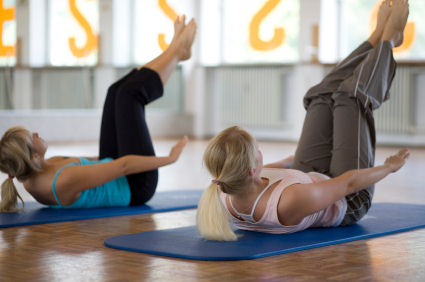 This is probably one of the most commonly asked questions a Pilates instructor gets asked. The technical answer to this question is "no", Pilates is not a cardio based form of exercise and therefore is not primarily designed to reduce body fat. The participant asking the question then feels confused, because the late-night infomercials claim that abdominal exercises help "spot reduce" and Pilates has a lot of abdominal exercise, right?
This is probably one of the most commonly asked questions a Pilates instructor gets asked. The technical answer to this question is "no", Pilates is not a cardio based form of exercise and therefore is not primarily designed to reduce body fat. The participant asking the question then feels confused, because the late-night infomercials claim that abdominal exercises help "spot reduce" and Pilates has a lot of abdominal exercise, right?Lets examine this in a little more detail. The fatty deposits stored around your torso are energy stores - a result of excess intake of energy (calories) and a deficit of energy expenditure. To access these energy stores, you need to be expending energy, and classically we recommend aerobic energy expenditure as the biggest consumer of these fat deposits. However, these fat stores are also the main source of energy for our less "active" pursuits - our daily incidental exercise, the base metabolic functions of the body, even sleeping and watching TV! The problem, is that these activities simply do not use enough of the fat stores to be considered relevant fat loss pursuits.
So, what about Pilates? Well, Pilates does involve some movement - though not enough to get you huffing and puffing and really eating into those energy stores. Many Pilates routines are designed to flow, elevating the heartrate and therefore providing a higher energy expenditure over the whole session. Pilates also recruits the use of a wide variety of muscles, in different ways of contraction. Resistance training is now being highly recommended as an important aspect of fat loss. Resistance training helps fat loss by increasing lean muscle mass which increases energy expenditure. So, is Pilates considered resistance training? Pilates often uses isometric muscle contractions - where the muscle is held in a stationary state. Pilates also frequently uses eccentric muscle contractions - where the muscle fibres are lengthened. Some of the Pilates exercises require a high intensity of muscle contraction, that you would describe as a resistance exercise.
In my personal experience, Pilates does help with fat-loss. I have had several clients lose weight - including fat from their abdominals, thigh and buttocks - from the practice of Pilates. I, also, have personally experienced a change in physique from the practice of Pilates. Despite being very active, including resistance training and cardio activity in my training routine - my body shows it when I miss my Pilates sessions.
What about the variety that Pilates can offer? Keeping your body in shape is about "mixing" it up and changing your routine. Your body adapts very quickly to new stimulus - therefore your same old routine or walking, running or swimming may just not be cutting it anymore. Sometimes, Pilates can be just the shift that you need. The other benefits - posture, core strength, relaxation and focus - are icing on the cake.
And what about those killer abs? Well, Pilates can have amazing visual results on the body. The simple process of "narrowing" the waist, tones your abdominal centreing muscles and your clothes suddenly feel looser. The toned appearance of the waistline, back, buttocks and shoulders also look great in your swimmers. When you walk past your reflection in that shop window, you suddenly look slimmer - and you're standing taller. People make comments on how great you look - you're alive with vitality and the amazing thing is your back is not hurting as much as it used to.
So what is really important? Keeping up your practice of Pilates, keeping your functional fitness level high and if you happen to look great after all that work - well, that's even better.

